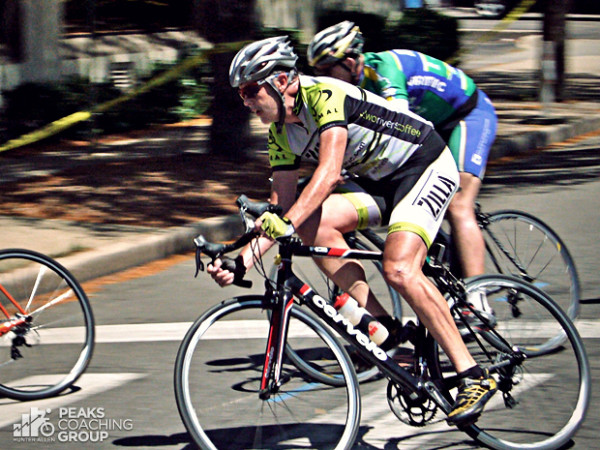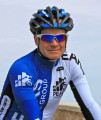By Tim Cusick, Peaks Coaching Group president and elite/master coach

I’m 48 years old, and I wanna go faster! There, I said it. This happens to me every fall; it’s something about the cool night air, changing colors, and Sunday night football. I start thinking about next year and planning ways to get faster. I love it. So few sports give us the opportunity to look for ways to improve even at the “mature” age of 48 (and way beyond).
I train with power, so my performance goals for next season are in watts. Somehow I will find away to squeeze a few more watts out of these old bones. I don’t care who says I’m too old or past my prime. I know that if I can find ways to improve my training, I might make it happen. Sure, the odds are against me: things don’t work as well anymore, there are a few more aches than last year, and occasionally I wonder how much gas I have left in the tank, but I DON’T CARE! I’m going for it anyway!
So as I sit down and start thinking about my 2015 plans, I figured I’d share a few of my tips. Click through to read them!
Limit the loss of Chronic Training Load (CTL).
As a long-time coach, I preach taking a nice long(ish) break in the fall for all my athletes under 35, but for those of us over 40 (yeah, yeah, I know I skipped five years; you can decide which side you are on), I go the other way. See, when you’re young and have some time, you can dump more fitness, rest up your system, start rebuilding again in the late fall/early winter, and regain your fitness, but once we start to age (for argument’s sake I’m talking 40+, but there’s really no hard number) we have to balance the rest more delicately, as building back is harder for us. Typically a young rider can handle a steady ramp rate of fitness growth of 6-7 chronic training load (CTL) points a week and maintain a good balance of fitness and freshness to train hard and realize gains, but once you’re over 40, that number goes down. I typically estimate it more like 4-5 CTL points a week. This limits the speed at which a masters athlete can gain fitness while still building performance.
The way to deal with this is to first accept it and then move on to planning accordingly. I start my season plan early and build CTL a little slower to ensure proper over-reaching and growth as I build to a target fitness.
Build some strength.
Just do it! This is a much-debated topic, but I see results time and time again. It’s doubly important for the masters rider. As we age, two key things we lose that hurt us in cycling are VO2max and strength (as a general term). The benefits of strength building are well noted in masters athletes, and you should be doing it. What is “it”? Here’s what I do myself and recommend to build strength:
1. Start with a functional strength-building program. The traditional definition of functional strength training is the practice of motion against resistance, with an objective of improving your ability to perform a specific athletic activity. A year’s worth of cycling, attached to your handlebars, saddle, and pedals, improves your fitness and performance, but it comes at a price, and your body can develop some imbalances and issues. The best way to begin your annual strength build regime is to start with a short (eight weeks) functional strength-building program. The program should focus on rebuilding and balancing cycling-specific strength by focusing on the motions of cycling while balancing out the support muscles. This phase is important because it’s the ground work of a more intensive strength-building program.
2. Once I complete my functional program, I move to a more traditional strength resistance program in the gym. This is typically ten to twelve weeks for me and includes a blend of programs. I know everyone fears weight gain, but if you do it correctly, you can minimize the weight gain, and actually lose some. My program is two weeks based on strength endurance (low weight, high reps), two weeks of hypertrophy (heavier weights, 8-12 reps), four weeks of strength building (heavy weights, low reps), and finishing up with two to four weeks of strength endurance building again.
3. Maintenance. I like to maintain strength once in season, but it’s a real time challenge. Once I complete my basic programs above, I try to stick to a maintenance program one or two days a week, but if time is limited, I choose time on the bike over time in the gym.
This combination seems to get me most prepared for the season, healthy and strong.
Change it up.
Another thing that gets harder as we get older: change. At 40+ it takes some extra discipline, but each year I challenge myself to introduce something new. Your body gets used to the “same-old-same-old” pretty quickly, so bringing in some new exercises is important. This year my new thing is a fitness course. You know that odd bunch of signs and bars circling your local park? Try reading those little numbered signs, and you’ll see they’re actually a series of progressive workouts, typically focused on body weight. My plan this year is to (carefully) introduce some running into some functional strength building and look to get some gains. I know this is a touch old-school, but I need something new, and a fitness course allows me to run on the grass, add functional strength movements, and actually create some intensity. You could argue that I might get better performance results from spending that time on the bike, but this isn’t performance phase; this is strength building. The change will force my body to adapt instead of being prepared for the same experience.
That gives you a really good start! It’s the simplest advice I have for masters riders who want to go fast: start early, build some strength, and change it up.
 Tim Cusick is a USA Cycling Level 3 coach and the president of Peaks Coaching Group. He and his coaches create custom training plans for all levels of athletes, and Tim can be contacted directly through PeaksCoachingGroup.com or info@peakscoachinggroup.com. Get more great tips and articles on the Peaks Coaching Group Power Blog.
Tim Cusick is a USA Cycling Level 3 coach and the president of Peaks Coaching Group. He and his coaches create custom training plans for all levels of athletes, and Tim can be contacted directly through PeaksCoachingGroup.com or info@peakscoachinggroup.com. Get more great tips and articles on the Peaks Coaching Group Power Blog.